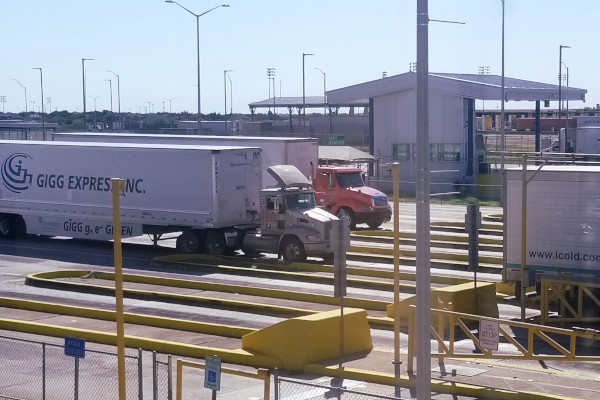Laredo is the largest U.S. land port. More than 14,000 trucks per day cross the border at Laredo.
I visited Laredo in October to see for myself. Jacob, one of our interns from the Reshoring Institute, came with me to assist with our research on cross-border commerce and the massive shift to nearshoring manufacturing. What we discovered was jaw-dropping volumes, advanced technology, community college education in trade compliance, and a welcoming business environment.
During the early 2000s, the U.S. economy became dependent on outsourced manufacturing to China. After China joined the World Trade Organization in 2001, the free flow of trade supercharged China’s economy and slowly drained America’s manufacturing prowess. Beginning in 2012, with the presidential race between Mitt Romney and Barack Obama, the threat of China to America’s manufacturing capability gained recognition, and the reshoring of manufacturing began. Over the next few years, companies started to consider the possibility of bringing some manufacturing back. Bolstered by the Tax Reduction Act of 2017, the Trade Wars starting in 2018, and the ongoing penalty tariffs on Chinese imports, it became increasingly urgent to reconsider manufacturing in China.
Some companies have remained in China or sought other low-cost manufacturing countries including Mexico. A study published by the Reshoring Institute found that Mexico is among the lowest-cost manufacturing countries in the world. In addition, Mexico already has well-developed manufacturing capabilities. Mexico’s proximity to U.S. markets and the potential for duty-free imports under the USMCA Trade Agreement, make this country attractive to manufacturers moving out of China. All of the ports and crossings along the border and the support facilities and businesses on both sides have benefitted tremendously from the nearshoring movement.
We stood at the approach to the World Trade Bridge in Laredo and watched the southbound truck crossings for a while. We were told that 14,000 trucks cross the U.S.-Mexico border every day. I asked three times for confirmation of this astonishing number and was told that the number is correct. This represents a 273% increase since 2022. To handle this astounding growth in truck crossings, the southbound crossing is automated with scanners. Trucks slow to about 20 mph as they transit through the scanning corridor where the truck is weighed, identified by both the power unit and the trailer, and facial recognition of the driver. The information is matched with export documentation preloaded into The U.S. Automated Export System (AES). If the match is correct and complete, the driver moves on into Mexico without stopping. By volume and value, automotive vehicles and parts are the biggest categories of goods crossing the border in both directions.
Laredo is the largest land crossing, but it is just one of many crossing points between the U.S. and Mexico, including the large ports of Brownsville, El Paso, Nogales, and San Diego/Otay Mesa. A new mega-bridge development called Puerto Verde is also been proposed and privately funded in Eagle Pass, TX.
The expected continued growth in cross-border commerce with Mexico is likely to attract new investment and the continued development and enhancement of bridges all along the border. The nearshoring activity to Mexico and reshoring to the U.S. will continue for years to come. Stay tuned to the Reshoring Institute for our coming research on cross-border commerce.
SC
MR


More Ports & Shipping
- U.S.-bound containerized import shipments are up in June and first half of 2024
- Building resilience in manufacturing
- One door closes, a better one opens
- AI liftoff delayed?
- The key to good data management? Start with good data
- Procter & Gamble’s Amy Rardin announced as NexGen Supply Chain keynote speaker
- More Ports & Shipping
Latest Podcast

 Explore
Explore
Topics
Procurement & Sourcing News
- AI-driven sourcing: Why the speed of change is going to only accelerate
- A Silk Road city
- U.S.-bound containerized import shipments are up in June and first half of 2024
- Boeing turned to Fairmarkit, AI to help land its tail spend
- When disaster strikes, the supply chain becomes the key to life
- A smarter approach to sustainability is vital for healthy, resilient supply chains
- More Procurement & Sourcing
Latest Procurement & Sourcing Resources

Subscribe

Supply Chain Management Review delivers the best industry content.

Editors’ Picks




